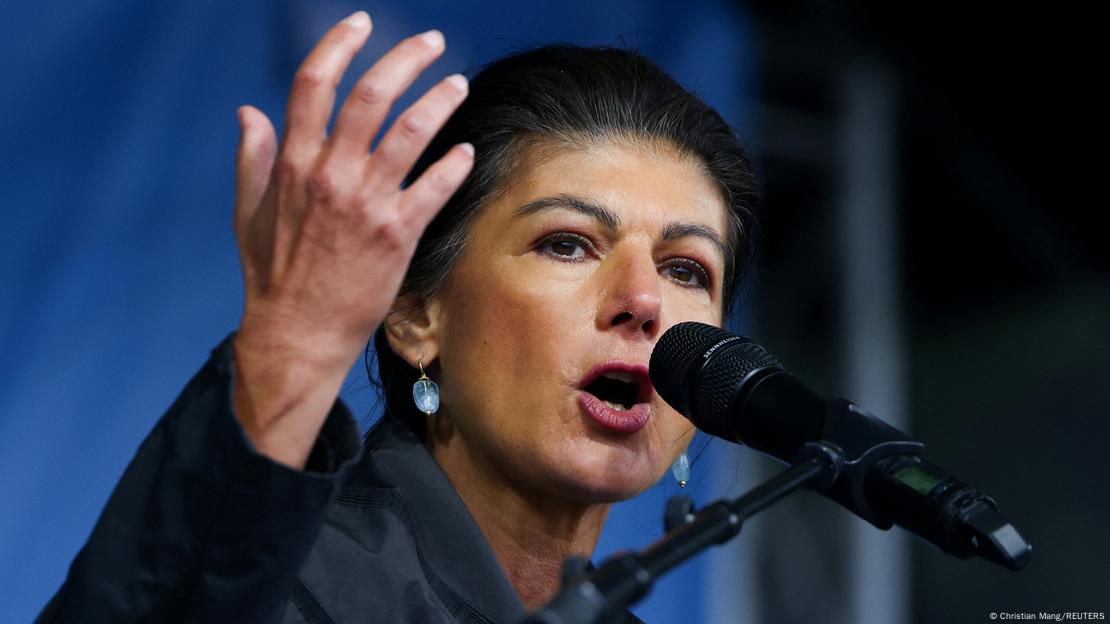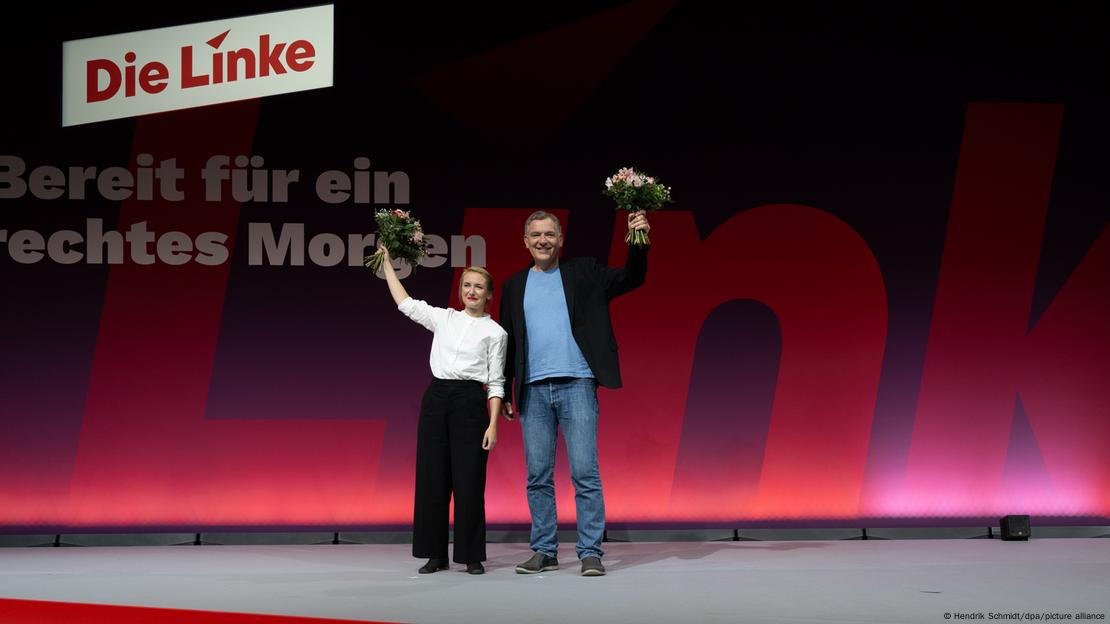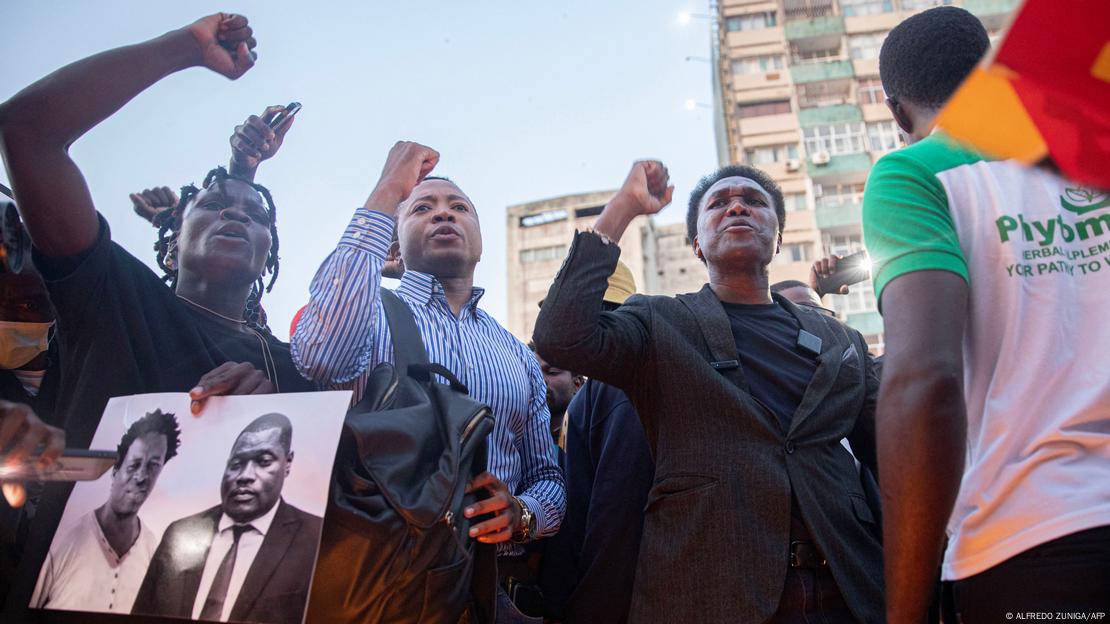Journalist Ines Schwerdtner and former lawmaker Jan van Aken were picked to lead the party into next year's election. The Left Party has been rocked by the departure of a key figurehead and plummeting voter support.
Ines Schwerdtner and Jan van Aken were picked by Left members at a party conference in Halle
Hendrik Schmidt/dpa/picture alliance
Germany's troubled Left Party announced two new leaders on Saturday — journalist Ines Schwerdtner and former parliamentary lawmaker Jan van Aken.
The pair were elected by members of the post-communist party at a national conference in the eastern city of Halle.
Schwerdtner received 79.8% of the votes, while van Aken won 88%, local media reported.
Why is this important?
The socialist Left Party has struggled for survival in recent years over the rise of the far-right in its traditional heartland of eastern German states. The far-right AfD has perhaps overshadowed the Left Party due to its strict anti-migration stance, with the Left Party also dealing with internal divisions.
One of the Left's most prominent members, Sahra Wagenknecht, quit last year to form a new populist anti-immigration party in her name: the Sahra Wagenknecht Alliance (BSW). The BSW also has far-left economic principles, but a more conservative approach on migration in comparison to the Left Party.
Wagenknecht took a large proportion of the parliamentary party with her, which caused the Left to lose its official status in the German lower house, the Bundestag.

Germany's troubled Left Party announced two new leaders on Saturday — journalist Ines Schwerdtner and former parliamentary lawmaker Jan van Aken.
The pair were elected by members of the post-communist party at a national conference in the eastern city of Halle.
Schwerdtner received 79.8% of the votes, while van Aken won 88%, local media reported.
Why is this important?
The socialist Left Party has struggled for survival in recent years over the rise of the far-right in its traditional heartland of eastern German states. The far-right AfD has perhaps overshadowed the Left Party due to its strict anti-migration stance, with the Left Party also dealing with internal divisions.
One of the Left's most prominent members, Sahra Wagenknecht, quit last year to form a new populist anti-immigration party in her name: the Sahra Wagenknecht Alliance (BSW). The BSW also has far-left economic principles, but a more conservative approach on migration in comparison to the Left Party.
Wagenknecht took a large proportion of the parliamentary party with her, which caused the Left to lose its official status in the German lower house, the Bundestag.

Sahra Wagenknecht has become a thorn in the side of Germany's socialist Left PartyImage: Christian Mang/REUTERS
Those misfortunes prompted outgoing leaders Janine Wissler and Martin Schirdewan to step down in August.
The Left also suffered heavy defeats in regional elections in Germany's eastern states last month.
What do we know about the new leaders?
Schwerdtner was born in Werdau, Saxony, in 1989 — the year the Berlin Wall fell.
She worked as a journalist and was co-founder and editor-in-chief of the socialist magazine "Jacobin."
Until 2022, Schwerdtner was involved in a group that campaigned to reform rent laws in Germany's capital, Berlin.
She only joined the Left in summer 2023 and ran for the party in the European elections in June but failed to secure enough support.
In her application speech on Saturday, Schwerdtner insisted the Left was still "the force of solidarity" in Germany.
She called for a party "that can change life for the better" and that represents "ordinary people."
Schwerdtner also singled out the Left as "the voice of the East," referring to eastern German states.
Those misfortunes prompted outgoing leaders Janine Wissler and Martin Schirdewan to step down in August.
The Left also suffered heavy defeats in regional elections in Germany's eastern states last month.
What do we know about the new leaders?
Schwerdtner was born in Werdau, Saxony, in 1989 — the year the Berlin Wall fell.
She worked as a journalist and was co-founder and editor-in-chief of the socialist magazine "Jacobin."
Until 2022, Schwerdtner was involved in a group that campaigned to reform rent laws in Germany's capital, Berlin.
She only joined the Left in summer 2023 and ran for the party in the European elections in June but failed to secure enough support.
In her application speech on Saturday, Schwerdtner insisted the Left was still "the force of solidarity" in Germany.
She called for a party "that can change life for the better" and that represents "ordinary people."
Schwerdtner also singled out the Left as "the voice of the East," referring to eastern German states.

Jan van Aken (R) joined the party in 2006, while Ines Schwerdtner signed up last yearImage: Hendrik Schmidt/dpa/picture alliance
Van Aken, meanwhile, sat as a lawmaker in the Bundestag for the Left Party from 2009 to 2017.
Before that, he was a biological weapons inspector at the United Nations and a genetic engineering expert at Greenpeace.
In his application speech, Van Aken insisted the Left Party's public support was "much livelier than the elections show," noting how there was "so much energy, so much fire" at the grassroots level.
Calling for a fairer distribution of wealth and more solidarity in society, the 63-year-old told members: "I think there should be no billionaires."
He also called for unity within the party after months of disquiet, adding "From now on, there's no more fighting."
What is the Left Party?
The Left Party (known as Die Linke in Germany) was founded out of a merger in 2007 of two left-wing parties.
Through one of its predecessors, the party is the direct descendant of the Marxist-Leninist ruling party of former East Germany.
The Left campaigns for democratic socialism as an alternative to capitalism, and has 28 seats in the 736-seat Bundestag, but their parliamentary faction was dissolved last year as a result of the party split.
This meant a severe loss of influence in the Bundestag, although its members still sit in parliament, some as non-aligned.
The declared goal of the Left Party is a full return to the Bundestag after Germany's 2025 federal election.
To do so, it would need to secure 5% of the national vote in the next election, scheduled for September 28.
In 2021, it achieved 4.9% support but was allowed to continue sitting in the Bundestag, thanks to a little-known rule.
Nationally, the Left is currently polling at 3-4%.
mm/wd (dpa, AFP)
Van Aken, meanwhile, sat as a lawmaker in the Bundestag for the Left Party from 2009 to 2017.
Before that, he was a biological weapons inspector at the United Nations and a genetic engineering expert at Greenpeace.
In his application speech, Van Aken insisted the Left Party's public support was "much livelier than the elections show," noting how there was "so much energy, so much fire" at the grassroots level.
Calling for a fairer distribution of wealth and more solidarity in society, the 63-year-old told members: "I think there should be no billionaires."
He also called for unity within the party after months of disquiet, adding "From now on, there's no more fighting."
What is the Left Party?
The Left Party (known as Die Linke in Germany) was founded out of a merger in 2007 of two left-wing parties.
Through one of its predecessors, the party is the direct descendant of the Marxist-Leninist ruling party of former East Germany.
The Left campaigns for democratic socialism as an alternative to capitalism, and has 28 seats in the 736-seat Bundestag, but their parliamentary faction was dissolved last year as a result of the party split.
This meant a severe loss of influence in the Bundestag, although its members still sit in parliament, some as non-aligned.
The declared goal of the Left Party is a full return to the Bundestag after Germany's 2025 federal election.
To do so, it would need to secure 5% of the national vote in the next election, scheduled for September 28.
In 2021, it achieved 4.9% support but was allowed to continue sitting in the Bundestag, thanks to a little-known rule.
Nationally, the Left is currently polling at 3-4%.
mm/wd (dpa, AFP)




 07:55
07:55






